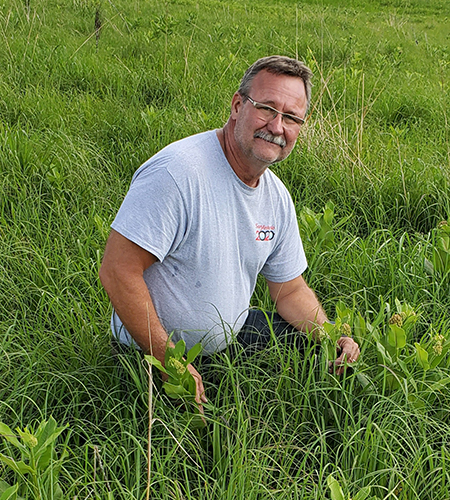Changing tillage systems has increased the soil’s organic matter, which benefits the crops and keeps the soil from blowing away. I can see a difference in the fields we’ve been operating longer. My goal is to constantly grow organic matter, eliminate nutrient loss and improve water quality.

Kelly Nieuwenhuis
O’Brien County

Farming Operation
- Third-generation corn and soybean farmer in northwest Iowa; farms with two brothers
- 100% of their corn is used in ethanol production
- 2021 vice president of the Iowa Corn Promotion Board
- Member of the National Corn Growers Association’s Ethanol Action Team
- Member of the U.S. Grains Council’s Ethanol Advisory Team
- On the board of Iowa’s Renewable Fuels Infrastructure Program
4R Plus Practices Used
- One-pass vertical tillage to work the ground 2 inches deep and leave 99% of residue on top
- Installed grass waterways and filter strips
- One-pass, low-volume urea application in the spring with nitrogen stabilizers and impregnated with pre-emerge herbicides; no use of anhydrous ammonia
- Regularly testing tile lines to assess water quality
- Flood-prone land enrolled in the Conservation Reserve Program
- Soil testing every four years to determine nutrient needs
Results Seen
- Vertical tillage has increased organic matter and has improved water holding, nutrient holding and carbon sequestering
- Increased populations of earthworms, which are an integral part of the soil’s biology
- Decreased the level of commercial nitrogen fertilizer applied
- Waterways and filter strips catch nutrients and control erosion
- Nitrate levels under 10 ppb (.01 ppm) in water from tile lines – the EPA nitrate standard for drinking water is 10 ppm
Plans for the Future
- Continue to increase organic matter to improve soil for the next generation
- Adopt improved technology – i.e., smart sensors that tell the temperature, moisture and organic matter in the seed furrow during planting; mapping to quickly find and fix problem spots in fields
- Continue communicating with landlords on the advantages of conservation practices
- Install waterways and filter strips on rented land where it will benefit the soil
- Look for ways to produce more using fewer resources
- Explore participating in the carbon credit market
Click here to ask Kelly Nieuwenhuis a question about the farming operation.
Harvest 2021: Scaling into 4R Plus Practices
Kelly Nieuwenhuis has seen a lot of production practice changes during his nearly 40 years of farming in O’Brien County, and he’s still trying new things. He’s looking ahead to next season and trialing several different 4R Plus practices, including seeding rye cover crops into no-till soybeans and trying out new biologic technology in hopes of reducing nitrogen application.
He’s excited by his results to date and hopes to expand on these efforts to build organic soil matter and improve water infiltration. But he says decisions won’t be based on a one-year trial. “I have to prove it’s economical and beneficial to my farming operation.”
Click here for the full story.
Summer 2021: Managing Crops Through Extreme Drought
Kelly Nieuwenhuis has seen drought conditions intensify through the growing season in O’Brien County, but says the crops are holding their own on his good ground. He attributed building organic matter using 4R Plus practices, like one-pass vertical tillage, as improving the water-holding capacity of the soil, which makes a difference in a year like 2021.
“Since the first of April through mid-July, we’ve had farms that have only received 2.9 inches of rain. But the highest one is over 5 inches total,” he said. “That’s a spread of 2 inches to 3 inches during the growing season, so it’s very variable.”
Click here for the full story.
Spring 2021: Multiple Advantages of Reduced Tillage
On the flat landscape in O’Brien County, Kelly Nieuwenhuis has been working to increase organic matter in the soil his entire farming career. After a long history in a full tillage program, he switched to one-pass vertical tillage in 2016 and has seen organic matter in the soil increase rapidly.
“We went to narrow, 20-inch rows in 2004, and in 2016, we switched to one-pass vertical tillage in the spring. Now we only work the ground 2-inches deep the day before we plant and leave 99% of residue on the top to protect the soil and absorb moisture,” he said. “Basically, we’re just airing out the soil and warming it up a little bit before planting.”
Click here for the full story.
